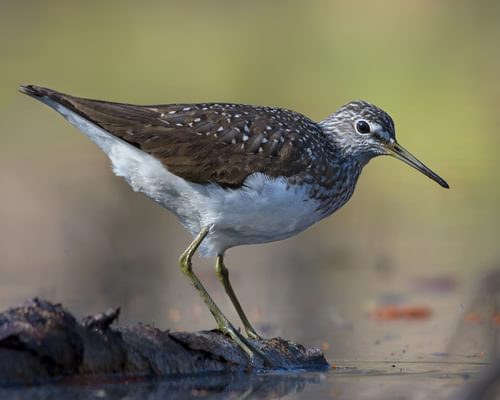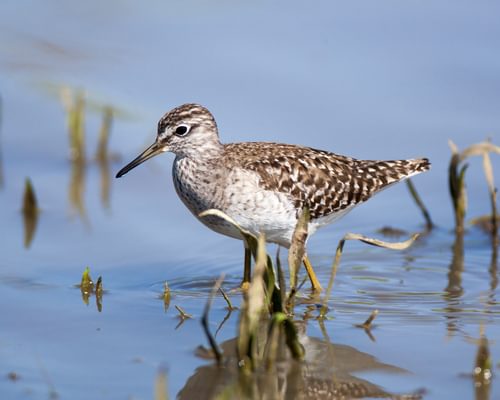Common Sandpiper
Least ConcernActitis hypoleucos
Visual Identification
Appearance
The Common Sandpiper displays a brown upperside with a distinctive white underside. Its back and wings have a mottled brown pattern, while the breast has fine brown streaks. The bird has a medium-length, straight bill and olive-green legs.
There is little difference between males and females. Juveniles resemble adults but have buff-tipped wing coverts and a more barred appearance on the upperparts.
Size
Length
18cm to 20cm
Wingspan
32cm to 35cm
Weight
40g to 60g
Colours
Males and females have similar plumage
Primary Colour
Brown White
Secondary Colour
Grey
Beak Colour
Dark Grey
Leg Colour
Olive
Habitat and Distribution
Habitats
Woodland
Garden
Wetland
Coastal
Urban
Farmland
Grassland
Desert
Tundra
Rainforest
Mountain
Savanna
Distribution
Common Sandpipers inhabit many freshwater and coastal habitats, including rivers, lakes, estuaries, and rocky shores. They breed across Europe and Asia, from the UK to Japan.
During winter, they migrate to Africa, southern Asia, and Australia. They are summer visitors in the UK, arriving in April and departing by September, with some birds overwintering in southern England.
Elevation Range
Up to 3,000 meters
Climate zones
Temperate, Tropical, Subtropical
Distribution Map
This map gives you a rough idea of where you might spot a Common Sandpiper. The coloured areas show countries where these birds have been seen.
A few things to keep in mind:
- Birds might not be everywhere in the coloured areas, for example, they may be present around the coast of that country
- Where birds live can change with seasons and available food
- This map is quite simple - it doesn't show exact locations
We're working on making our maps even better! Soon, we hope to show you:
- More detailed maps for bigger countries, including state and region
- How birds move around during different seasons
Distribution by Region
Behaviour and Ecology
Bird Attributes
This feature is in beta. We'd love your feedback to improve it!
Share your thoughtsBird Attributes Explained
Our bird attributes system rates various aspects of a bird's capabilities on a scale of 0-100, based on data from field observations, scientific studies, and expert knowledge.
Attribute Categories:
- Agility: Manoeuvrability, speed, and grace in flight or movement.
- Strength: Physical power, often correlating with size and hunting abilities.
- Adaptability: Ability to thrive in various environments or changing conditions.
- Aggressiveness: Territorial behaviour and assertiveness, particularly during breeding seasons.
- Endurance: Stamina, often seen in migration patterns or foraging behaviours.
Understanding the Ratings:
- 0-20: Very Low
- 21-40: Low
- 41-60: Average
- 61-80: High
- 81-100: Very High
Remember, these attributes are relative to other bird species and don't necessarily indicate superiority.
Hover over the icon next to each attribute for more information.
Tap the icon next to each attribute for more information.
Agility
Reflects the bird's manoeuvrability, speed, and grace in flight or movement.
The Common Sandpiper exhibits remarkable agility, demonstrated by its distinctive 'teetering' walk and ability to navigate varied waterside terrains. Its quick, nimble movements along shorelines and capacity for swift, low flights over water indicate high manoeuvrability.
Strength
Indicates the bird's physical power, often correlating with size and hunting abilities.
Whilst not particularly strong for its size, the Common Sandpiper possesses adequate strength for its lifestyle. It can carry out long-distance migrations and perform display flights, but its small size and reliance on agility over power suggest moderate strength.
Adaptability
Represents the bird's ability to thrive in various environments or changing conditions.
This species shows high adaptability, thriving in diverse habitats from freshwater bodies to coastal areas across multiple continents. Its ability to swim and dive when threatened, despite lacking webbed feet, further demonstrates its adaptiveness.
Aggressiveness
Measures the bird's territorial behaviour and assertiveness, particularly during breeding seasons.
Common Sandpipers are not notably aggressive birds. They're often seen foraging alone or in small groups and are more likely to flee from threats than confront them. However, they may display some territorial behaviour during breeding season.
Endurance
Reflects the bird's stamina, often seen in migration patterns or foraging behaviours.
The Common Sandpiper demonstrates considerable endurance, particularly during its long-distance migrations. Some individuals can fly up to 6,000 km during these journeys, indicating robust stamina. Their ability to breed at elevations up to 3,000 metres also suggests good endurance.
Diet
Common Sandpipers primarily feed on small invertebrates such as insects, crustaceans, and worms. They forage by picking prey from the ground or water's surface, often running along shorelines and probing in shallow water with their bills.
Behaviour
Vocalisation
The Common Sandpiper's call is a distinctive, high-pitched 'tweet-tweet' or 'swee-wee'. During the breeding season, males produce a trilling song in flight, described as a rapid series of 'ti-ti-ti' notes. Their alarm call is a sharp, piercing 'peet'.
Nesting & Breeding
Common Sandpipers form monogamous pairs during the breeding season, which typically begins in May. Males perform display flights to attract females, often calling loudly.
Nests are usually shallow scrapes on the ground, lined with grass and leaves, often hidden in vegetation near water. Females lay 3-4 eggs, which are pale buff with brown spots.
Both parents incubate the eggs for about 21-22 days. Chicks are precocial and can leave the nest shortly after hatching, fledging after 26-28 days.
Lifespan
years
The Common Sandpiper typically lives for 8 to 10 years.
Like all birds, lifespan can be affected by factors including predation, habitat quality, disease, and access to food sources.
Conservation and Status
Global Conservation Status
While listed as Least Concern globally, Common Sandpipers face threats from habitat loss and degradation. Conservation efforts focus on protecting wetlands and coastal areas, particularly their breeding grounds in northern Europe and wintering sites in Africa and Asia.
Birdwatching Tips
- Look for their distinctive bobbing motion along shorelines
- Listen for their sharp, clear 'tweet-tweet' call
- Observe their low, skimming flight over water
- In the UK, watch for them near freshwater bodies from April to September
Additional Information
Quick Facts
Other names:
Eurasian Sandpiper
Family:
ScolopacidaePredators
Did You Know?
- Common Sandpipers can swim and dive when threatened despite not having webbed feet.
- They have been known to return to the same breeding site for multiple years.
- Some individuals can fly up to 6,000 km during migration.
Was this bird profile helpful?
Your feedback helps us improve our content
Thanks for your feedback!
Your input helps us improve our content.
Community Experience
Community Ratings
No ratings yet - be the first to rate this bird!
Latest Community Reviews
No reviews yet
Sign in to be the first to review
Community Reviews
Create Your Free Account Welcome Back!
Join our community to rate birds and share your experiences. Creating an account is completely free and only takes a minute. Sign in to your account to rate birds and share your experiences with our community.
Your information is secure and will never be shared.
By creating an account, you agree to our Privacy Policy.
Similar Birds
References
- 1
website: BirdLife International. 2016. Actitis hypoleucos. The IUCN Red List of Threatened Species 2016: e.T22693264A86678952.
View source - 2 3
report, 2015: Wetlands International

